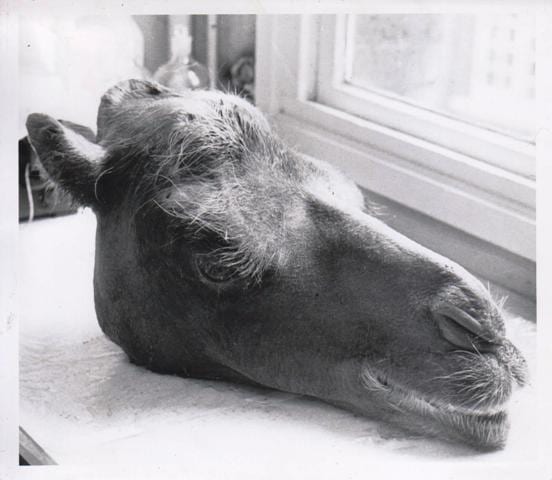From the Archives: A Camel Head from London Zoo
By Mark Carnall, on 8 October 2014
Here at the Grant Museum, we have a large collection of documents, photographs, negatives and other ephemera which make up the archive of the collection. Part of my ongoing role as the curator of the Grant Museum is to ensure that all of this archival information is attached to the relevant museum specimens so we have as much as a history of possible of the lives and after lives of our specimens. This marks the first post in what will be occasional series highlighting interesting finds about the museum and the specimens from the archive.
This first post contains some rather grim imagery so the images are after the jump but whilst rifling through the archives I found images of a bactrian camel head which had been sent to UCL from London Zoo. POTENTIALLY DISTURBING IMAGES HERE ON IN.

Bactrian camel head being prepared in the Grant Museum in 1964. The skull LDUCZ-Z2604 is now on public display
According to the notes associated with these images this is the head of a bactrian camel received from London Zoo. These images show the head before and after skinning prior to the preparation of the skull.
The skull was prepared by museum technician Jeanie Thompson in 1964 according to the specimen label and these photos were taken by former Grant museum curator Roy Mahoney. In the past the museum was equipped with a range of preparation facilities and included live animals in terrarria for students to observe. This specimen was probably prepared in maceration tanks that used to be on the roof of UCL and where our not-an-anaconda specimen was prepared too.
Interestingly, this specimen was only recently accessioned despite being at UCL since 1964. It wasn’t identified to species level and we didn’t have the historical information about the preparation associated with the specimen. Thanks to this find I’ve been able to flesh out the history of this specimen with these images of defleshing. A perfect example of why archive information is so important.

Here’s the camel skull on display in the museum today (top right) complete with the tags from London Zoo
The skull prepared from this specimen is still on display in the museum but you’ll have to borrow a pair of binoculars from the front desk to see it as it’s in one of our high display cases with another camel and tapir skulls.
Mark Carnall is the Curator of the Grant Museum of Zoology
 Close
Close


